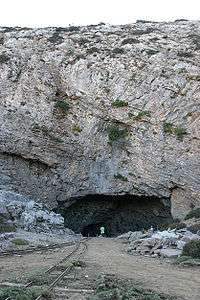Mount Ida
In Greek mythology, two sacred mountains are called Mount Ida, the "Mountain of the Goddess": Mount Ida in Crete; and Mount Ida in the ancient Troad region of western Anatolia (in modern-day Turkey) which was also known as the Phrygian Ida in classical antiquity and is the mountain that is mentioned in the Iliad of Homer and the Aeneid of Virgil. Both are associated with the mother goddess in the deepest layers of pre-Greek myth, in that Mount Ida in Anatolia was sacred to Cybele, who is sometimes called Mater Idaea ("Idaean Mother"),[1] while Rhea, often identified with Cybele, put the infant Zeus to nurse with Amaltheia at Mount Ida in Crete. Thereafter, his birthplace was sacred to Zeus, the king and father of Greek gods and goddesses.[2]
Etymology
The name Ida (Ἴδη) is of unknown origin. Instances of i-da in Linear A probably refer to the mountain in Crete. Three inscriptions bear just the name i-da-ma-te (AR Zf 1 and 2, and KY Za 2), and may refer to mount Ida [3] or to the mother goddess of Ida ( Ἰδαία μάτηρ). In Iliad (Iliad, 2.821), Ἵδη (Ida) means wooded hill, and reminds the mountain worship in the Minoan mother goddess religion.[4] The name is related with the nymph Idaea, who according to Diodor was the mother of the ten Kuretes.[5] Idaea was also an epithet of Cybele. Romans knew Cybele as Magna Mater ("Great Mother"), or as Magna Mater deorum Idaea ("great Idaean mother of the gods"), equivalent to the Greek title Meter Theon Idaia ("Mother of the Gods, from Mount Ida").[6] Proclus considered it as the "mount of the Ideas", whence its etymology.[7]
Mount Ida, Crete

Crete's Mount Ida is the island's highest summit, sacred to the Goddess Rhea, and wherein lies the legendary Idaean cave (Ἰδαίον ἅντρον)), in which baby Zeus was concealed from his father Cronus. It is one of a number of caves believed to have been the birthplace or hiding place of Zeus.[8] The Kouretes, a band of mythical warriors, undertook to dance their wild, noisy war dances in front of the cave, so that the clamour would keep Cronus from hearing the infant's crying. On the flank of this mountain is the Amari Valley, the site of expansion by the ancient settlement at Phaistos.[9] Its modern name is Psiloritis. The surrounding area and mountain used to be very wooded.
Mount Ida, Anatolia
From the Anatolian Mount Ida, Zeus was said to have abducted Ganymede to Olympus. The topmost peak is Gargarus, mentioned in the Iliad. Zeus was located in the Altar of Zeus (near Adatepe, Ayvacık) during the Trojan War. The modern Turkish name for Mount Ida, Turkey, is Kaz Dağı, pronounced [kaz daːɯ]. In the Aeneid, a shooting star falls onto the mountain in answer to the prayer of Anchises to Jupiter.
2019 environmental protests
In July 2019, protesters came to the village of Kirazlı, about forty kilometres away from Mount Ida, to protest against the construction of a new mine by Canadian company Alamos Gold, after the Forestry Department cleared thousands of trees to make way for the construction, despite this region being Forestry lands actively managed by the Ministry of Forests. Local people from Kirazli and other nearby villages, employed in forestry, agriculture and mining strongly support the project. Protesters began a "Water and Conscience Watch" on July 26. A "Great Water and Conscience Meeting" was then held on August 5, during which protesters entered the mining site and symbolically planted trees in front of the press.[10] Images of the land which had been cleared of trees also caused outrage on social media.[11] Artist Zülfü Livaneli wrote an open letter to UNESCO protesting about the destruction of the natural environment in the area.[12]
Notes
- Maarten Jozef Vermaseren and Eugene Lane. 1996 Cybele, Attis and Related Cults: Essays in Memory of M.J. Vermaseren, (Leiden: Brill), ISBN 90-04-10196-9, ISBN 978-90-04-10196-8
- Homer Odyssey xix. 172; Plato, Laws i. 1; Diodorus Siculus, v. 70; Strabo x. p. 730; Cicero, De natura deorum, iii. 21
- Richard Valance
- Nagy, Gregory (1963). "Greek-Like Elements in Linear A". Greek, Roman, and Byzantine Studies. Harvard University Press (4): 200.CS1 maint: ref=harv (link) p.200
- F.Schachermeyer(1964) Die Minoische Kultur des alten Kretap. 266 . W. Kohlhammer Stuttgart
- Beard, p.168, following Livy 29, 10 - 14 for Pessinos (ancient Galatia) as the shrine from which she was brought. Varro's Lingua Latina, 6.15 has Pergamum. Ovid Fasti 4.180-372 has it brought directly from Mt Ida. For discussion of problems attendant on such precise claims of origin, see Tacaks, in Lane, pp. 370 - 373.
- Anne D. R. Sheppard, Studies on the 5th and 6th essays of Proclus' Commentary on the Republic, Vandenhoeck & Ruprecht in Göttinger, 1980, p. 66.
- William Smith, ed. (c. 1873). A Dictionary of Greek and Roman biography and mythology. John Murray.
- C.Michael Hogan. 2007. Phaistos Fieldnotes, The Modern Antiquarian
- BIA News Desk (5 August 2019). "'Great Water and Conscience Meeting' in Ida Mountains". Bianet. Archived from the original on 5 August 2019.
- BIA News Desk (29 July 2019). "Thousands of Trees Cut in Mount Ida for Gold Mine, People on the Watch". Bianet. Archived from the original on 5 August 2019.
- BIA News Desk (5 August 2019). "Open Letter by Zülfü Livaneli to UNESCO: They Will Destroy Ida Mountains". Bianet. Archived from the original on 5 August 2019.
External links
| Wikisource has the text of The New Student's Reference Work article about "Mibora minima". |